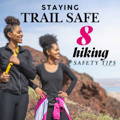“Don't forget to pack a self-defense weapon and first aid kit when you hit the trail."
Staying Trail Safe: 8 Hiking Safety Tips
Hiking is one of the most rewarding ways to connect with nature, challenge your body, and clear your mind. Whether you're trekking through dense forests, scaling rocky inclines, or strolling a quiet meadow trail, preparation and awareness are crucial to ensure a safe and enjoyable adventure. While many hikers focus on gear and terrain, self-defense preparedness is an often-overlooked aspect of trail safety, yet it can be a lifesaver in unpredictable situations.
Below are eight critical safety tips every hiker should follow to stay safe on the trails.
1. Plan and Share Your Route
Before setting foot on the trail, invest time in understanding your route. Research maps, trail difficulty, elevation changes, potential hazards, and estimated hike time. Many national parks and hiking apps provide detailed trail guides, recent trail condition reports, and user reviews.
Once your plan is solid, share your hiking itinerary with a friend or family member. Include your starting point, destination, estimated time of return, and any alternate routes you may consider. In the unfortunate event that you don’t return as expected, rescuers will have a clear idea of where to begin their search. This step is especially important when hiking in remote areas where phone signal is weak or nonexistent.

2. Pack the Safety Essentials
Hiking safely means carrying more than just water and a snack bar. A well-packed backpack should include:
• Plenty of water (or a filter/purification tablets if hiking near streams)
• High-energy food
• Navigation tools: physical map, compass, or GPS device
• Fully charged phone with a power bank
• Self-defense weapon(s)
• Weather-appropriate layers (think moisture-wicking clothes, rain jacket, gloves)
• Flashlight or headlamp with extra batteries
• First aid kit with basics like bandages, antiseptic, pain relievers, and tweezers
• Fire starter (lighter, waterproof matches)
• Emergency whistle or mirror
A compact survival blanket and multitool can also be invaluable in an emergency. Don’t assume short hikes require less preparation—accidents and weather changes can happen quickly, even on well-marked trails.
3. Stay Aware of Your Surroundings
Situational awareness is one of your best tools in staying safe. Stay alert to changing conditions, trail markers, and any unusual activity around you. Avoid wearing both earbuds at the same time—keeping one ear free allows you to hear approaching people, wildlife, or environmental cues like cracking branches or rushing water.
Know how to identify common animal tracks and sounds, and don’t get so focused on your destination that you miss warning signs along the way. Stop periodically to take note of landmarks, especially on trails that are not well-marked. It’s easy to become disoriented in dense woods or winding desert paths.

4. Be Prepared for Self-Defense
Personal safety isn’t just about avoiding slips and falls. Trails can be isolated, and while rare, encounters with aggressive people or animals can happen. It’s wise to carry a self-defense tool tailored to outdoor environments.
Popular trail-friendly options include:
• Pepper spray: Lightweight and easy to deploy; effective against humans and some wildlife.
• Personal alarms: These devices emit loud, high-pitched sounds to startle threats and draw attention.
• Compact stun guns: Some models double as flashlights and can deter both animals and potential attackers.
• Tactical pens or keychain tools: Easy to carry and can be used as striking tools if needed.
Familiarize yourself with your chosen self-defense tool. Practice deploying it quickly and understand its range and limitations. Many tools are legal to carry in public parks, but always check local regulations before heading out.
“Use apps to stay connected and link to satellite service in dead zones.”

5. Stay Visible and Connected
Wearing bright, reflective, or high-visibility clothing increases your chances of being seen by other hikers, rescuers, or even wildlife that may avoid you due to your presence. A reflective vest or backpack cover can help if visibility becomes poor due to fog or dusk.
Because many trails have limited cellular reception, it’s wise to invest in a personal locator beacon (PLB) or satellite communicator. These devices use satellite signals to send your location and emergency alerts, even in dead zones. They’re especially vital for solo hikers or those venturing into remote wilderness.
6. Monitor Weather Conditions
Weather can shift quickly on the trail, especially in mountainous or high-elevation regions. What starts as a sunny morning can turn into a hailstorm or lightning-filled downpour by afternoon. Hypothermia, heatstroke, and dehydration are all real risks—even on short hikes.
Before heading out, check the hourly forecast, wind speeds, and any advisories issued for the region. During the hike, keep an eye on the sky and temperature changes. If you notice fast-moving clouds or sudden drops in temperature, consider turning back or finding shelter.

7. Hike Together or Stay Connected
There’s safety in numbers. Whenever possible, hike with a buddy or group. Not only does this reduce the chance of being targeted by potential threats, but it also increases your odds of receiving help quickly in case of an accident or injury.
If you do hike alone, check in periodically with a trusted contact. Apps like Bivy or Garmin’s tracking systems allow others to see your real-time location (assuming you have signal or a satellite device). A quick check-in text at trail milestones can be reassuring for loved ones—and a backup plan if something goes wrong.
8. Trust Your Instincts and Act Confidently
Confidence can be a powerful deterrent. Walk with purpose, make eye contact with other hikers, and be prepared to assert boundaries if someone makes you uncomfortable. Avoid appearing lost or unsure, and never be afraid to turn back if a situation doesn’t feel right.
If confronted, don’t hesitate to use your voice. A loud “STOP” or “BACK OFF” can shock someone out of aggressive behavior and alert others nearby. Combine verbal commands with the use of a personal alarm or pepper spray if needed.
Hiking is an empowering, enriching experience—but it demands respect for nature and an awareness of your own vulnerability. With thoughtful preparation, the right tools, and a self-defense mindset, you can fully enjoy the trail without unnecessary risk. Your safety is not negotiable—equip yourself wisely, hike smart, and never underestimate the power of being prepared.
Defense Divas® wants you to be equipped to defend yourself not only with a self-defense weapon, but also with the practical knowledge of safety awareness and prevention.
Follow us on your favorite social media platforms (@DefenseDivas) to receive safety tips, product videos and more in your daily feed. Leave us a comment and introduce yourself too!
Copyright©2025 All rights reserved. This article or any portion thereof may not be reproduced or used in any manner whatsoever without the express written permission of Defense Divas®.


